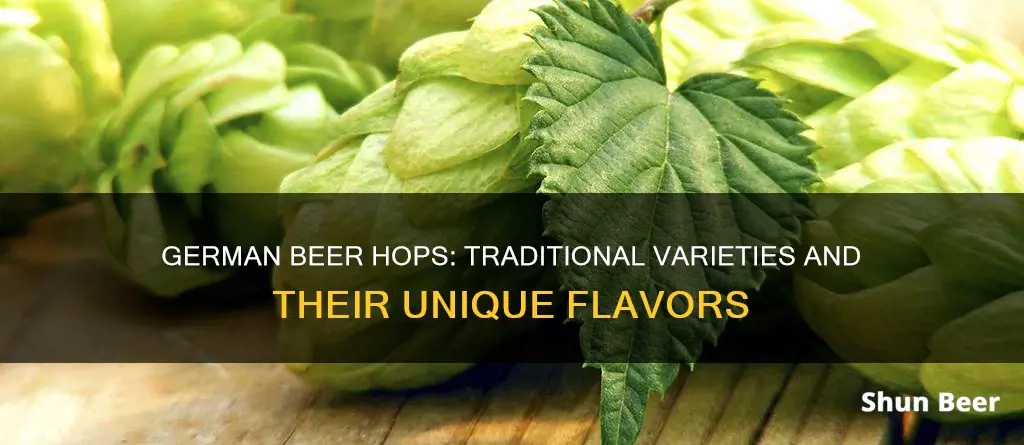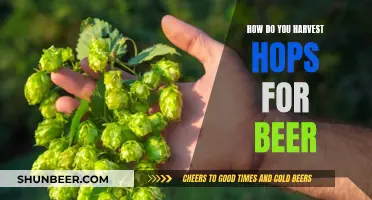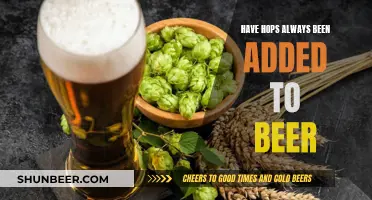
Germany has a long history of hop cultivation, with the first documented instance of hop cultivation in the world taking place in the Hallertau region of present-day Germany in 736. Today, Germany has four main hop-growing regions: Hallertau, Elbe-Saale, Tettnang, and Spalt. The Hallertau region accounts for almost 90% of all German hops grown and is also a center of hop research and breeding.
There are four hops varieties that are considered noble hops: Hallertau, Saaz, Spalt, and Tettnang. These hops are named after the regions in which they were grown and are known for their low alpha acid content and strong aroma profiles. They are commonly used in traditional continental-style lagers and ales.
Other traditional German hops include Hersbrucker, Perle, and Magnum.
| Characteristics | Values |
|---|---|
| Region | Hallertau, Spalt, Tettnang, Žatec (Saaz) |
| Other Names | Hallertauer, Holledau, German Lager Hop |
| Alpha Acid Content | 3.5–5.5% |
| Beta Acid Content | 3–4% |
| Aromatics | Earth, spice, citrusy nectar |
What You'll Learn

Hallertau hops
Some examples of beers brewed with Hallertau hops include:
- Pilsner Gold by Ninkasi
- Pacific Wonderland Lager by Deschutes
- Harpoon Goldenmilk by Harpoon
Hops' Role in Extending Beer's Shelf Life and Stability
You may want to see also

Tettnang hops
These hops are well-suited for use in European lagers and pilsners, as well as Hefeweizen beers. They are often used in traditional German lagers, particularly Bavarian styles, Weissbiers, and German or Belgian ales. Tettnang hops can be added at any stage of the brewing process, making them a versatile option for brewers.
The sensory profile of Tettnang hops includes a mix of floral, fruity, herbal, and spicy notes, such as fresh herbs, grass, dried flowers, citrus peel, and black tea. They can add a bit more intensity to a brew compared to Hallertau, while still maintaining a balanced flavour. Tettnang hops have a mild, pleasant, and well-rounded aroma, making them a popular choice for brewers looking to create complex and delicate flavours in their beers.
Hopping Techniques for the Perfect NEIPA Brew
You may want to see also

Spalt hops
The Spalt hop variety matures early and grows vigorously, with red bines and long lateral branches. However, it yields a relatively small amount of cones, resulting in a low average yield of only about 1,200 to 1,600 kg/ha. The alpha and beta acids in Spalt hops range from 4% to 5%, which is consistent with other Noble hop varieties. The cohumulone content is moderate, at 23% to 28% of alpha acids. The essential oils found in Spalt hops include myrcene (15%), humulene (25%), caryophyllene (15%), and a high level of the floral farnesene (15%).
The Success Story of Tropical Hop Beers
You may want to see also

Saaz hops
In addition to their flavour and aroma, Saaz hops also offer practical benefits to brewers. Their elevated content of polyphenols helps to abate oxidation, resulting in a longer shelf life for beers brewed with these hops. However, growing Saaz hops can be challenging due to their meagre yield, weak mildew resistance, and light cones. To address these issues, the original Saaz variety has been successfully cloned multiple times to improve its resistance to wilt and mildew and make it a more viable crop.
While the original Saaz hops are associated with Czech brewing traditions, another variety has been propagated in the United States. This US variety has a higher alpha acid content than the original Czech version, making it more suitable for bittering applications.
Kegging Beer: Reducing Hops for a Balanced Brew
You may want to see also

Hersbrucker hops
The hop is characterised by its mellow spiciness and is often described as having a citrus and herbal aroma, with notes of dried green herbs, candied citrus, and tree fruit. Its sensory profile is similar to Mittelfrüh but with a more dominant spice component and added elements of fruit.
Hersbrucker is an aroma hop, typically used in late boil additions and dry hopping. It is a popular choice for refined European-style beers and traditional Southern German beers, including lightly-hopped lagers and ales. It is well-suited to Munich-style pale and dark lager, Weissbier, Oktoberfest, and Bock. Its versatility also extends to hop-forward lagers like Pils, and it can add a pleasant blend of fruity and spicy notes to these styles.
With an annual production exceeding 1000 metric tons, Hersbrucker hops are widely available and can be purchased from multiple suppliers, including some organic options from boutique hop farms.
Hops in Beer: Healthy or Harmful?
You may want to see also
Frequently asked questions
German hops are hops grown in Germany, which has four main hop-growing regions: Hallertau, Elbe-Saale, Tettnang, and Spalt.
German hops are known for their low-yielding aroma hops, which impart a range of flavours and aromas to beer, such as earthiness, spice, and citrus.
There are four types of German hops that are considered "noble hops": Hallertau, Saaz, Spalt, and Tettnang.
German hops are commonly used in brewing to add bitterness, flavour, and stability to beer. They can also be used for dry-hopping, whirlpool additions, and biotransformation.
Some specific examples of German hops include Hallertau Mittelfrüh, Tettnanger, Spalt, and Hersbrucker.







